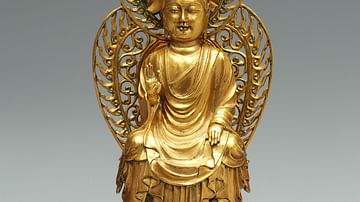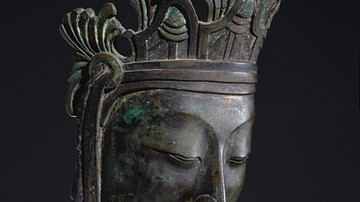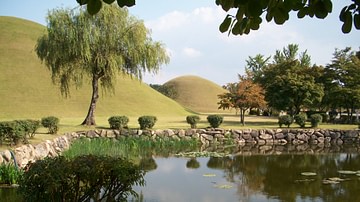Buddhism was introduced from China to ancient Korea in the 4th century BCE and adopted as the official state religion by the Kingdoms of Baekje, Goguryeo, and Silla. The faith split into separate divisions across Asia, one of the most important being Seon (Son) Buddhism, also called Chan Buddhism, but better known in the western world by its Japanese pronunciation, Zen Buddhism. Zen Buddhism emphasised the necessity of meditative contemplation (son) in order to reach full enlightenment and claimed that scriptures could not fully express the principles which must be grasped by the individual mind alone. Over time this branch split into many sub-branches with some shunning scriptures all together and others conceding at least some necessity for intellectual studies.
Introduction to Korea
Having arrived in China with the Indian monk Bodhidharma in the 6th century CE, Zen Buddhism reached the Korean peninsula sometime in the late 7th or early 8th century CE. It was brought by the monk Pomnang (c. 632-646 CE) who had studied in Tang China. One of the first Zen monasteries was built by the monk Sinhaeng (d. 779 CE) and the faith was further spread by the work of another monk, Toui (d. 825 CE), who founded the Mt. Kaji sect at Borimsa. The strict monastic discipline required to fully practise this version of Buddhism did not prevent it gaining popularity, especially from the 9th century CE when the Nine Mountain Schools (kusanmun) flourished. These were so named for the nine most important monasteries which promoted Zen Buddhism. Zen Buddhism became especially popular with landed gentry (the hojok) as its individualism appealed to their own anxiety to be independent of the central government.
Principal Doctrines
As with other branches of Buddhism, there was a hierarchy of priests and entrance examinations for those wishing to enter the monastic life. The lowest rank was Monk Designate (taeson) while the highest was Great Seon Mentor (taesonsa). Although Zen Buddhism had many versions, the historian K. Pratt presents the following ideas central to meditative Buddhism, as summarised in A History of Chinese Philosophy, vol II (1953):
- Ultimate truth is inexpressible.
- Spiritual cultivation is not possible.
- In the last resort, nothing is gained.
- There is nothing much in Buddhist teaching.
- The dao [path] lies in carrying water and chopping wood. (433)
Enlightenment was available to all and could arrive through meditation as inside everyone is the nature of Buddha. During meditation, to help the mind free itself of clutter and remove the outer layers of worldly desire, sutras (Buddha's sermons) were chanted and Buddha's name recited. Another method to help the mind concentrate was the contemplation of koans – unsolvable or nonsense problems. This approach was introduced to Korea by the monk Jinul (1158-1210 CE), and it was thought that by having the mind endlessly revolve around such problems enlightenment would arrive in an unexpected and brilliant flash of inspiration.

As the study of texts was considered less important than the notion of passing on knowledge from teacher to student, the Zen masters were greatly venerated. This was especially so following the death of a master (sonsa), and great monuments were erected in their honour, notably stupas. These contained the ashes of the deceased and were often accompanied by a stone stele describing the monk's achievements. The oldest such stupa, set up to honour the monk Yomgo, was built in 790 CE, while one of the most impressive is that of Doyun, founder of the Mt. Saja sect (one of the Nine Mountain sects), at Ssangbongsa in Hwasun. The inscription stones are not only a valuable source of history but they are an important record of Korean calligraphy too. One such stone was written by the great scholar-monk Choe Chiwon.
Evolution in Korea
Zen Buddhism was often at odds with the other major form of Buddhism in ancient Korea, Kyo Buddhism, which stressed the importance of scriptural studies as opposed to meditation to achieve enlightenment. Taejo of Goryeo (r. 918-943 CE), the founder of that dynasty, instructed his successors to support both forms of Buddhism. Then the monk Uicheon (1055-1101 CE) went a step further and famously attempted but ultimately failed to bridge the gap between these two major branches of Buddhism. Another monk, Jinul (1158-1210 CE), was more successful in combining the two approaches as epitomised by his famous maxim: 'sudden enlightenment followed by gradual cultivation.' Jinul's unifying and inclusive form of Buddhism is known as Jogye Buddhism, and it became the official state religion of Korea and remains popular today.
This content was made possible with generous support from the British Korean Society.






